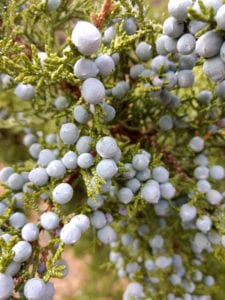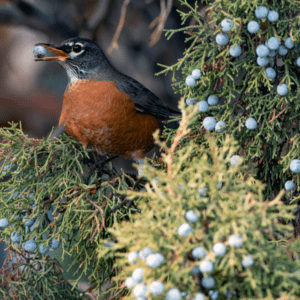Author: Scott Bowler | Published: December 21, 2022 | Category: Species Spotlight
This article originally appeared in The Source on December 7, 2022.
The ubiquitous tree that warrants a closer look
If it seems to you like juniper are everywhere, well, they are. Western juniper is among the most common trees in Oregon — in some areas, essentially the only tree. Once thought to be all one species, recent scientific work has shown that there are actually two species of Western juniper, although the one you see in Oregon are Juniperus occidentalis.
 Western juniper possess a paradoxical dual nature. They are delicate young trees, yet tough and long lived. They are fire susceptible when young, yet resistant as old specimens. About half are monoecious (containing either male or female reproductive structures), and about half are dioecious (containing both sexual structures). This dual nature of sexual reproduction can be confounding because the roughly half that manifest as either male or female, do so in a changeable ratio that can vary from year to year depending upon growing conditions. Male reproductive structures produce pollen, and female structures produce those small orbs commonly referred to as “berries,” which show great variability in abundance. Since juniper are conifers, those aren’t berries, but rather a tiny cone, housing a couple seeds, covered with a fleshy outer layer, that in turn hosts a protective yeast bloom on its surface.
Western juniper possess a paradoxical dual nature. They are delicate young trees, yet tough and long lived. They are fire susceptible when young, yet resistant as old specimens. About half are monoecious (containing either male or female reproductive structures), and about half are dioecious (containing both sexual structures). This dual nature of sexual reproduction can be confounding because the roughly half that manifest as either male or female, do so in a changeable ratio that can vary from year to year depending upon growing conditions. Male reproductive structures produce pollen, and female structures produce those small orbs commonly referred to as “berries,” which show great variability in abundance. Since juniper are conifers, those aren’t berries, but rather a tiny cone, housing a couple seeds, covered with a fleshy outer layer, that in turn hosts a protective yeast bloom on its surface.
Western juniper’s duality appears again in the way they offer habitat to both predators and prey. Chipmunks and golden mantled ground squirrels live in cavities in old trunks and forage in the canopy, as do the owls and hawks that hunt them. Insects attracted to juniper fruits are eaten by bats that roost in the trees gnarled bark. Juniper roots can house both coyote dens and rabbit burrows. Deer shelter under them, even as cougars stash their carcasses up in the branches.
Perhaps it is all this duality that earns them mixed reviews from people. Some Central Oregonians see juniper as useless trash trees; others enjoy their lumber in our homes, their “berries” flavoring our gin, or their lovely aroma as a Christmas tree or wood burning in our campfires. Beauty is in the eyes of the beholder to be sure.
 Two bird species, American robin and Townsend’s solitaire, are particularly fond of those berry-shaped cones. Both of these bird species also love the insects, worms and fruits in our farms and gardens, and have helped spread juniper far and wide. Interestingly, there’s evidence that bird population swings and juniper reproductive abundance are tied together: warmer, wetter weather makes good conditions for junipers, who make more berries, which attracts more birds. Life makes more life, an expansion of resources in one area bumping up resources in another.
Two bird species, American robin and Townsend’s solitaire, are particularly fond of those berry-shaped cones. Both of these bird species also love the insects, worms and fruits in our farms and gardens, and have helped spread juniper far and wide. Interestingly, there’s evidence that bird population swings and juniper reproductive abundance are tied together: warmer, wetter weather makes good conditions for junipers, who make more berries, which attracts more birds. Life makes more life, an expansion of resources in one area bumping up resources in another.
This now ubiquitous tree was once much less dominant in this landscape. It grew only in areas with poorer soils, or rocky ridge lines, where competition from bunch grasses and shrubs was limited, and where fire did not often reach. Bunch grasses are highly fire-adapted with dense root mats and fast growth. These bunch grasses were very successful in the historic pattern of more frequent small fires — sometimes set by Native tribes to improve hunting and foraging — and they easily out competed thirsty young juniper.
Today, juniper cover an estimated three times as much land in Oregon as they did in pre-European settlement times. How did that happen? As in so many areas of life, “it’s complicated,” but a key driver was the proliferation of open range livestock grazing — just at the same time as climactic conditions were swinging favorably for juniper. While Native inhabitants had long set small fires, European settlers tended to suppress fires. As shrub communities were altered and livestock consumed bunch grasses, their grazing simultaneously introduced and enhanced the spread of invasive grass and weed species. All of these disruptions enabled juniper to thrive and spread.
The juniper population boom presents a dilemma. Though they are native, scenic, and wonderful habitat for many wildlife species, juniper are also notoriously thirsty trees that, at the expense of declining bunch grass communities, pull tremendous amounts of water out of this arid landscape. As juniper expand beyond their historic range and density, millions of public dollars are being spent to control juniper through cutting and burning — largely short-term efforts — without adequately addressing the root causes.
The next time you walk by a Western juniper, likely today, marvel at this species adaptability and complexity, and perhaps view it as an opportunity to restore balance to the landscape.
About the author: Scott Bowler is a retired science educator and frequent ONDA volunteer. Read more of his work.